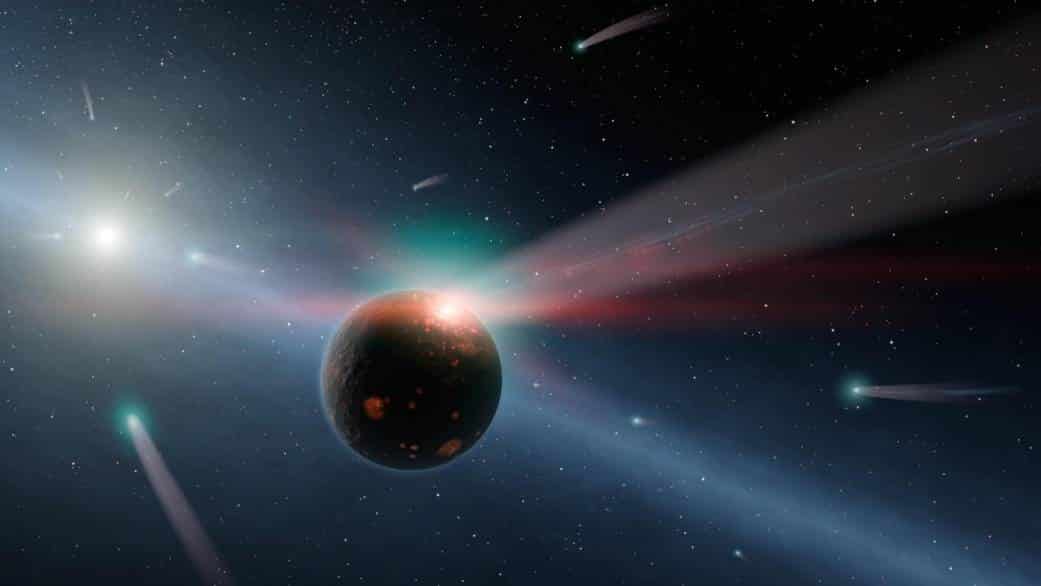
Earth is also known as the “blue planet”, since around 70% of its surface is covered by water. No other planet in our solar system can be compared to Earth, although the oceans and lakes around the globe are not the only sources of water in the solar system. However, most of the non-earthly water is frozen. For example, the polar caps on Mars and some Jupiter moons are covered by ice, and on Jupiter’s moon Europe there are even indications of oceans under the ice. Furthermore, there are lots of comets traveling through the galaxy and they consist mostly of ice and, according to the latest findings, exactly such comets may be responsible that there is water on earth – and therefore also life.
Thanks to the latest scientific findings about comets, some secrets are now being revealed as to where all the water on earth came from. Based on the results of their studies, the researchers assume that the water of Earth’s oceans and the water on many comets have the same origin. According to this, the water of the oceans had its origin on comets that collided with our planet billions of years ago.

Dirty snowballs
The decisive factors for these findings were data from the Stratospheric Observatory for Infrared Astronomy, SOFIA, which observed Comet Wirtanen as it passed Earth in December 2018. The collected data showed that this comet contains “ocean-like” water. A comparison with information about other comets suggests that “many more comets than previously thought” could have delivered water to Earth.
“We have identified a vast reservoir of Earth-like water in the outer reaches of the solar system,” said Darek Lis, a scientist at NASA’s Jet Propulsion Laboratory, in Pasadena, California, and lead author of the study. “Water was crucial for the development of life as we know it. We not only want to understand how Earth’s water was delivered, but also if this process could work in other planetary systems.”
New planets are formed by the gradual accumulation of debris, dust, and gas orbiting in a disk shape around a star. Small pieces of debris stick together and grow larger over time to eventually form asteroids, planetesimals, and planets. Leftover debris remains in regions like the Kuiper Belt, beyond Neptune, or the Oort Cloud, beyond Pluto. These areas are home to these “dirty snowballs” of rock, dust, ice, and other frozen chemicals that partially vaporize as they get closer to the Sun and produce the trails seen on images of comets,” NASA astronomers explain.
Different types of water
It is still a mystery to the scientists where this water on comets comes from, but with special instruments, they can detect two types of water: regular water, H2O, and heavy water, HDO, which has an extra neutron inside one of the hydrogen atoms. If a comparison of the two types of water now shows that the water on Comet Wirtanen and in the oceans have the same H2O and HDO ratio, one can assume that the water of the comet and the water of Earth’s oceans have the same origin.

However, making this comparison is difficult, because ground and space telescopes can only study comets in such detail if they are close enough to Earth. Visits to comets such as Rosetta are rare. Therefore, scientists have only been able to study this ratio of about a dozen comets since the 1980s. Moreover, it is difficult to examine the water of a comet from Earth “because water in Earth’s atmosphere blocks its signatures.”
Yet, thanks to the high altitude at which SOFIA operates, it was possible to accurately measure the ratio of regular to heavy water in Comet Wirtanen, and the data actually showed that the ratio is the same as Earth’s oceans.
Surprise findings
In a further comparison of the new SOFIA data with earlier studies of comets, they found a surprising similarity. The ratio of regular to heavy water was the same for all comets, whether they came from the Oort Cloud or the Kuiper Belt. “Instead, it was related to how much water was released from ice grains in the comet’s coma compared to directly from the snowy surface.” Thus, it appears that the water on comets always has the same ratio of H2O to HDO, which suggests that much of the water in Earth’s oceans could have been delivered by comets.
“This is the first time we could relate the ratio of heavy to normal water of all comets to a single factor,” noted Dominique Bockelée-Morvan, scientist at the Paris Observatory and the French National Center for Scientific Research and second author of the paper. “We may need to rethink how we study comets because water released from the ice grains appears to be a better indicator of the overall water ratio than the water released from surface ice.”
The researchers say that further studies are needed to confirm these findings and to find out whether they also apply to other comets. The next opportunity for such studies will be in November 2021, when another comet comes close enough to Earth.

SOFIA
The Stratospheric Observatory for Infrared Astronomy is the world’s largest airborne observatory and a joint project of the German Aerospace Center (DLR) and the National Aeronautics and Space Administration (NASA). The flying observatory for receiving terahertz radiation is a Boeing 747SP jetliner modified to carry a 106-inch diameter telescope that can be deployed at an altitude of 12 to 13 kilometers. NASA’s Ames Research Center in California’s Silicon Valley manages the SOFIA program, science and mission operations in cooperation with the Universities Space Research Association headquartered in Columbia, Maryland, and the German SOFIA Institute (DSI) at the University of Stuttgart. The aircraft is maintained and operated from NASA’s Armstrong Flight Research Center Building 703, in Palmdale, California.
The latest findings were published in Astronomy and Astrophysics Letters.
You might also like:
German astronomers discover 18 Earth-sized exoplanets
Asteroids Help to Calculate the Size of Distant Stars
Einstein was Right After All: First Picture of a Black Hole
The Milky Way Weighs 3 000 000 000 000 000 000 000 000 000 000 000 000 000 TONS
ESO’s VLT Shows Bubbles of Brand New Stars
Hubble Discover the Brightest Quasar in the Early Universe
Hubble Find More Evidence for Moon Outside our Solar System








